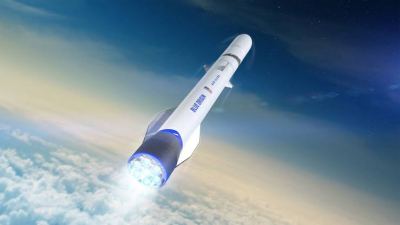In 2021 Rocket fans will soon be able to follow in Jeff Bezos’ footsteps when it comes to ownership of a suborbital New Shepard space vehicle.
Just be warned that everything will be scaled down: The Blue Origin New Shepard model rocket unveiled this week by Estes Industries will be 1/66th scale, and capable of going up 400 feet rather than 62 miles.
At least the price is scaled down as well: Instead of paying out a billion dollars a year to support Blue Origin’s development program for New Shepard as well as the orbital-class New Glenn rocket and advanced projects, buyers will be asked to shell out a mere $69.99.
Estes is partnering with the Club for the Future, Blue Origin’s educational foundation, to offer New Shepard as a STEM teaching tool. A portion of the sales proceeds will go to the club.
“Our hope is that the new Estes New Shepard model sparks the imagination of future space explorers and inspires them to carve out their own role in helping to invent the future of life in space,” Josef Reinke, director of the Club for the Future, said in a news release.
Estes’ pint-sized New Shepard is available for pre-order from Blue Origin’s online store as well as Estes’ website, with delivery anticipated in November.
Each box will include a Club for the Future postcard for kids to draw or write their vision of how they see the future of life in space.
The postcards can then be sent to the Club for the Future, which will put them on a New Shepard flight and then return them to the senders with an official-looking “Flown to Space” stamp.
This week’s announcement comes a little more than a month after Bezos and three crewmates took a suborbital ride to space in a New Shepard capsule, and coincides with today’s successful uncrewed flight of a different New Shepard known as the RSS H.G. Wells.
New Shepard isn’t the first commercial rocket to be turned into a model rocket: A decade ago, Estes sold SpaceShipOne model rockets that paid tribute to that rocket plane’s history-making spaceflights in 2004. And for a while, SpaceX sold model-rocket versions of its workhorse Falcon 9
Paintings, not people, take the spotlight in Blue Origin’s latest suborbital space trip
A little more than a month after Amazon founder Jeff Bezos took a rocket ride, his Blue Origin space venture set another New Shepard suborbital spaceship to the final frontier — but this time the high-profile payloads were paintings, not people.
Blue Origin’s 17th New Shepard mission lifted off from the company’s suborbital spaceport in West Texas at 9:31 a.m. CT (7:31 a.m. PT) today, after a couple of countdown holds that provided opportunities for last-minute checks of the rocket and its payloads.
The reusable vehicle that Bezos and three crewmates rode last month was optimized to fly passengers, but the spaceship for today’s flight was optimized to carry research payloads instead.
No humans were riding along for this particular rocket ship’s eighth suborbital outing.
The flight followed the standard profile for New Shepard: The hydrogen-fueled booster pushed the capsule to an altitude of 347,434 feet (105.9 kilometers), which is above the 100-kilometer (62-mile) “Karman Line” that marks a widely accepted outer-space boundary.
Minutes later, the booster touched down autonomously on a landing pad not far from the launch site.
“Just like she was landing on the moon,” launch commentator Jacki Cortese said.
Meanwhile, the capsule experienced a few minutes of weightlessness, and then floated down to a parachute-aided landing in the West Texas desert.
The flight took 10 minutes from launch to the capsule’s touchdown.
Suggested article – World’s first flying bike is coming in 2023
This mission’s primary research task was to test a precision landing system for NASA, following up on an initial test conducted last October. The guidance system is designed for use aboard crewed lunar landers for NASA’s Artemis program.
There were 18 other scientific payloads tucked inside the New Shepard capsule, 11 of which received financial support from NASA. One payload tested a process for turning common spaceflight waste products into exhaust gases and useful resources such as water and propellant. Another payload put a novel method for measuring propellant levels to the test in zero-G.
But the marquee payloads actually rode on the exterior of the capsule: In cooperation with Utah-based Uplift Aerospace, Blue Origin flew three portraits that Ghanaian artist Amoako Boafo painted on the capsule’s main chute covers.
“Suborbital Triptych” depicts Boafo’s mother; the mother of fellow artist Otis Kwame Kye Quaicoe, a childhood friend of Boafo’s; and Boafo himself.
Bezos shared images of Boafo and the artwork on Instagram after the landing:
“A self-portrait looking up to the skies best explains what this project means to me,” Boafo said in a pre-launch statement. “I grew up knowing the sky was the limit, and now I get to work on a project that goes beyond the sky as we know it.”
“Suborbital Triptych” is meant to be the first in a series of “Art x Space” philanthropic initiatives organized by Uplift.
Blue Origin also flew thousands of postcards sent in by kids under the auspices of the Club for the Future, the company’s nonprofit educational foundation. Some of those cards had an extra connection to the contemporary art world: They’re decorated with space-themed graphics from a music video that was created for OK Go Sandbox’s #ArtTogetherNow initiative.
The first launch of the orbital-class New Glenn rocket has been delayed until late 2022, and Blue Origin is late delivering its BE-4 rocket engines to United Launch Alliance, one of its closest partners in the space industry.
At this week’s Space Symposium in Colorado Springs, United Launch Alliance CEO Tory Bruno said he expected the first flight-ready BE-4 engines to be delivered for ULA’s next-generation Vulcan rocket by the end of this year. Bruno acknowledged the delivery would be “later than we had planned for,” but he insisted that he was “very, very happy” with the BE-4’s performance during testing.
On yet another front, Blue Origin has filed a lawsuit in federal court protesting NASA’s decision not to fund a lunar lander development program that’s led by Bezos’ company. During today’s webcast, Blue Origin repeatedly emphasized its efforts to lay the groundwork for missions to the moon, including the construction of an outdoor testbed with artificial craters and other hazards.
NASA and SpaceX have held up work on a $2.9 billion lunar lander contract pending the outcome of Blue Origin’s lawsuit. An expedited decision is expected around Nov. 1 — which just might come on the heels of Blue Origin’s next crewed spaceflight.
Stay tuned for more space news

















